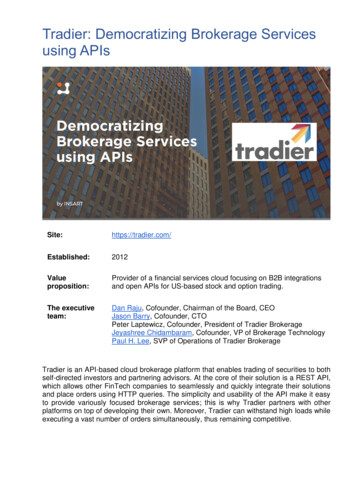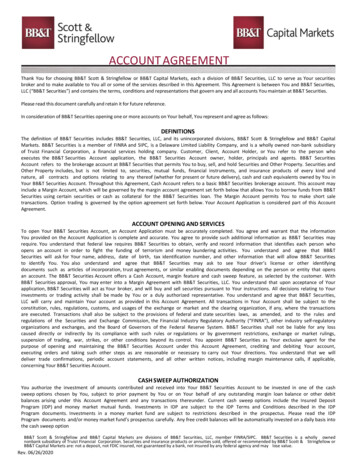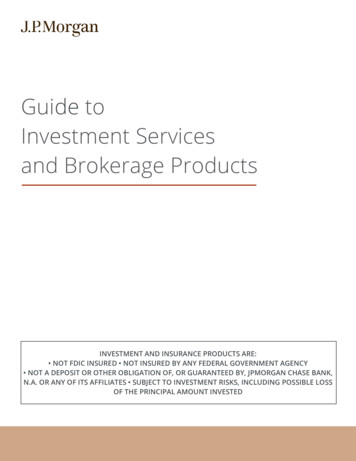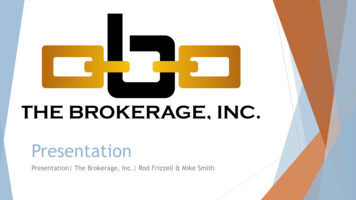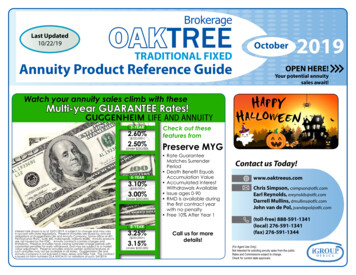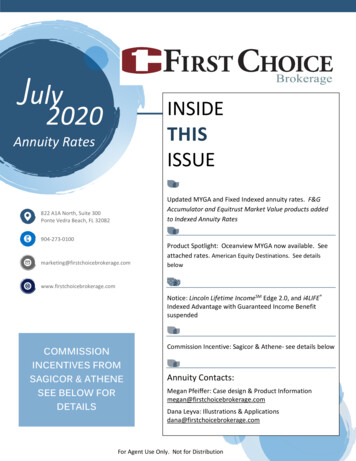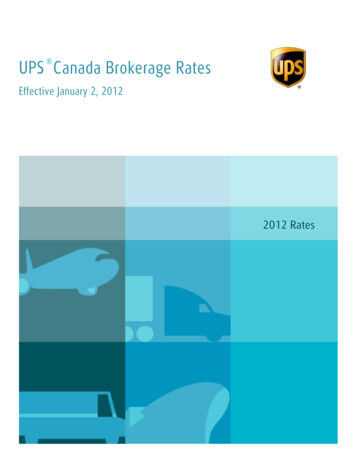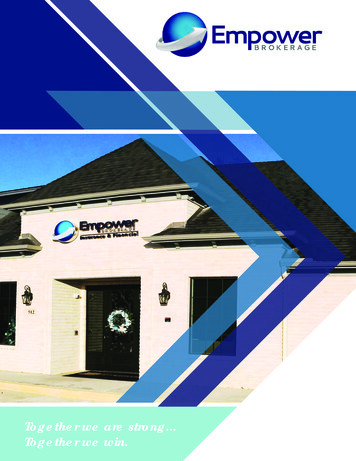
Transcription
Oxygen: The Prime Brokerage ProtocolWhite PaperDecember 2020For the most up to date information on Oxygen Protocol, visit our website1
Public equity trading is in a golden age. Apps like Robinhood, Revolut,eToro and Public have democratized investing for the masses; today, an investor can take out their phone and buy shares of publicly listed companies inseconds. This trend has created trillions of dollars of volume, certified the nextgeneration of unicorns, and, in many ways, defined 2020.Compare this to a few decades ago, when buying stocks meant driving to abrick-and-mortar stock brokerage, talking with your financial advisor, arranginginstructions, and waiting days for those to be processed, all with unknown andoften egregious fees.What changed? How did we get here from there?The key, really, was technology. As trades migrated from paper to the internet, the cost of trading went down. Without the need for multiple peopleto be involved in manually processing each transaction, trades started whizzingby, each recorded and settled automatically. At the same time, a combinationof API feeds and ubiquity of smartphones meant that everyone could streammarket data, send back an order execution instruction, and receive a fill, inseconds.While some of these APIs existed even in the 1990s, the financial and regulatory costs of using them fell drastically over the subsequent three decades tonear zero. Even until last year for a single trade on some major platforms likeFidelity and Schwab could cost retail customers up to 5, effectively pricing outmuch of the market. But now that cost is near 0, and usage has skyrocketed.The same can’t be said of more complex products. Prime brokerages, facilitators of trading and leverage for institutional clients and hedge funds, actas gatekeepers to most of the space. The manual, bespoke effort going intobuilding and maintaining those relationships means that only large institutionshave access to most of the world’s structured products and margined services.Decentralized Finance (DeFi) is a movement to replicate the financial constructs of traditional finance without a centralized organization controlling them,allowing anyone with a smartphone and an internet connection to have access.The blockchain is in some ways an open and permissionless model for an APIfeed, allowing anyone with a Web 3.0 wallet to access data freely and executetransactions. Different protocols in DeFi hint at what borrow/lending desks,pools, exchanges, and structured products could look like if they were open andscalable.The fees paid to middlemen and investment banks get replaced by blockchainand protocol fees, and the API feeds are free. And just this year, we’ve seen anexplosion in DeFi protocols, predominantly built on Ethereum. There is morethan 14.4B in total value locked in DeFi at the moment. DeFi borrow-lending2
protocols like Aave and Compound have over 3B in total assets under management, and have grown 20x since the summer1 .But we’re in the early and expensive days of DeFi protocols: the old Schwabmodel, rather than Robinhood. On Ethereum, each transaction can cost upwards of a few dollars2 , the blockchain has a maximum capacity of 15 transactions per second. That’s a lot better than having to drive to a physicalbrokerage, but a far cry from commission free trading at the click of a button.However, reduction in cost and increase in capacity is happening in thebroader blockchain industry. On Solana, a blazingly fast public blockchain,transaction costs is closer to 0.00001, and the blockchain can support up to50,000 transactions per second, with a block time of 400 milliseconds3 . At thatscale, Solana can process the transactions of a mass audience for essentially nofixed cost: exactly what’s needed to power an industry.But being cheap and fast isn’t enough – you also need customers. The current userbase on the Solana blockchain is small, but by Robinhood’s scale sois all of DeFi. Indeed, all of DeFi combined has less than 1 million lifetime users.In order for a marketplace based DeFi protocol to achieve huge success, itwould need to master four core components: (1) solve a pressing need (2) with awell-designed protocol (3) built on scalable technology (4) with a massive userbase.Introducing Oxygen: an on-chain prime brokerage built on theliquid and growing Serum ecosystem, running on Solana’s scalableblockchain, and seeded by the 140M users of the Maps.me 2.0, anon-chain mapping and fintech application.41Oxygen Protocol: Pool-based financial infrastructure starting with a borrow/lending protocolPrime brokerage is a core building block for financial markets. It connects various market participants - hedge funds, institutions, pension funds, insurancecompanies, asset managers and liquidity providers - contributing towards market efficiency and price discovery, as well as facilitating leveraged trading andasset lending. It is estimated that the revenues of the prime brokerage industry1 1.7Bin Compound. 1.7B in Aave2 https://ycharts.com/indicators/ethereumaverage transaction fee3 https://solana.com/4 https://docsend.com/view/fe3s3gusb84w7a2a3
will surpass 30B5 in 2020 and over 4.2T6 of securities have been lent andborrowed between Q1-Q3 in 2020 by US Banks.Prime brokerages are only accessible to larger financial institutions with assets exceeding hundreds of millions of dollars. This exclusivity is not by designbut reflects an economic reality: the costs of coordination, risk management andhuman capital incurred while providing these financial primitives have historically made it prohibitive to serve anyone other than the ultra-wealthy. In fact,like most marketplaces, prime brokerage7 themselves benefit when additionalinstitutions onboard.Oxygen Protocol is starting by building a prime brokerage designed to caterto the needs of DeFi applications and users. Oxygen is built around Pools8 , baskets of assets that take collective actions. By having a permissionless, cheap, andscalable prime brokerage protocol, Oxygen will democratize borrow/lending andmake it more efficient for all participants. We expect to address the followinguse cases directly:1. Yield generation: users can deposit funds and earn yield on their assets.2. Borrowing: users can borrow assets from a pool, paying interest to thepool3. Trading: users can trade directly out of the pool, allowing for collectiveaction and efficient capital usage4. Synthetic Products: trade more complex products using their pool’s assetsas collateralFollowing the Prime brokerage protocol, we plan to create volatility tradingprotocols and structured product constructors to enable people to create theirown structured products for themselves and for their clients - all on-chain.The borrow/lending protocol is just the beginning. Our vision is to recreatemarketplace-esque business units which exist within investment banks and makethem accessible to everyone.1.1Oxygen Protocol: Secure, On-Chain Protocol Designedfor Capital EfficiencyPrime brokerage desks within investment banks intermediate most markettrading activities for hedge funds and institutional investors. They hold the5 talise/6 http://bankregdata.com/allOBmet.asp?met SLB7 They take upto 80% of the fee paid by hedge funds for borrowing assets and only 20% isgiven to the lender.8 Pools (Portfolios) are generalized primitive whereby the account can hold assets, allow forcreations (redemptions) based on inflows (outflows) and trade as a unit.4
power to change rules arbitrarily, like pulling financing or significantly increasingmargin requirements. They often charge a hefty intermediation fee to connectdemand and supply. For example, in stock lending, pension funds often get 20%of the stock loan rate that hedge funds pay to borrow the pension fund stocks,with the prime broker taking the remaining 80% cut. This market is massiveyet opaque with almost 10% of all equities available to borrow, yielding over 30B annually for these investment banks.In DeFi, these services are provided via smart contracts, ”code is law”9 .Oxygen protocol is decentralized, non-custodial, and fully on-chain. All transactions are purely peer-to-peer with no involvement from a centralized operator.Oxygen protocol never has access to users’ private keys. All the transactions areauditable, immutable, and final. The clearing price for borrowing / lending isdetermined by the market - through on-chain order-book matching using SerumDEXes. Finally, the risk management and liquidation systems are completelyon-chain. The Oxygen Protocol will be verifiably transparent and deterministic.Moreover, the borrow-lending protocol on Oxygen has been carefully designed with the primary goal of capital efficiency, so that our users can get moreout of their money while also being more secure than in traditional finance.Capital Efficiency1. Multiple use of the same collateral - Lending enables you to generateyield on your portfolio, while borrowing other assets at the same time.Cross-collateralization - With Oxygen, you can utilize all of your portfolioas collateral when you want to borrow other assets. This should meanlower liquidation risk for your portfolio.2. Market-based pricing - Oxygen protocol is order-book based, ratherthan following a pre-set market model that requires manual adjustment.This means you get the fair price for borrowing/lending every time.3. In-pool trading - rather than forcing you to continually deposit andwithdraw from your account, Oxygen will allow users to interact with theSerum ecosystem and DEXes directly from their pools, streamlining theprocess.4. Sophisticated products - because Oxygen uses a general on-chain riskmanagement engine evaluating each user’s pool rather than a fixed borrow/lending model, it is built to support arbitrary products: tokens, synthetic products, nonlinear assets, and more; all cross-margined in the sameaccount.9 And it is not to say that decentralized finance platforms haven’t had their fair share ofissues and unexpected behavior. Most decentralized finance platforms bottom out at somecentralized price oracle, often the key source of vulnerability.5
Risk Management and Liquidation on OxygenFrom a user’s perspective, the Oxygen protocol is very similar to other borrow/lending protocols. The user creates a pool and deposits their assets, marking the assets that can be lent out and the corresponding terms. When a matchis successful, i.e.-there is a borrower willing to pay the specified interest rate,the assets are lent out and the lending user receives passive income. They canuse the pool to borrow different assets if needed10 . The borrows (loans) can beclosed at any time by paying (receiving) back the borrowed assets.Risk modelHowever, as the prices of the underlying assets vary, the value of the loansand borrow also vary. Therefore, we require a liquidation and risk management engine that can make sure that all loans are solvent and backed. In thebeta version11 of Oxygen protocol we will use the following risk and liquidationmechanics:1. The pool can increase leverage as long as Pool LTV Initial LTV.2. When the Pool LTV Maintenance LTV: The Pool LTV needs to be restored to Reset LTV within a certaintimeframe (”margin call timing”) through putting in more assets ordeleveraging. If the pool does not receive the expected additional collateral or otherwise deleverage before the end of the margin call period, the poolis in default and can enter into liquidation.3. If at any time Pool LTV Critical LTV: The pool can immediately go into liquidation if any user initiates it.10 Inparticular, you can borrow upto: Initial Loan-To-Value for the pool (%) * Value of thepool (USDc)11 We expect the parameters, data source and other constants to be either updated viagovernance proposals or dynamically based on market conditions and concentration limits.These include parameters such as: Initial, Maintenance, Critical and Reset LTVs for a given asset in a normalised environment Adjustments to Initial, Maintenance, Critical, Reset LTVs in different volatility / liquidity regimes Adjustments to LTVs for asset concentration / diversification margin-call timing - The time to allow pool owner to bring pool LTV to reset LTV Liquidation strategy and modelsIn the alpha version the initial LTV Reset LTV and Critical LTV Maintenance LTV(implicitly, margin-call timing 0). In the beta version, we’d expect Initial Reset Maintenance Critical LTV and the exposition refers to this case.6
Liquidation ModelOnce the liquidation is triggered by an initiator, the liquidation price for thepool assets is fixed. The following happens:1. Liquidation Initiator has 1 minute exclusivity after the change of state ofthe pool into Liquidation State to buy pool assets (proportionately) ata discount (based on Liquidation discount table which will be ¡ 1.0) inexchange for one or several tokens that the pool owes.2. After the first minute, any Liquidator can buy assets in the portfolio atthe Liquidation Discount in exchange for one or several tokens that thepool owes.For technical specification, and risk/liquidation mechanism please see documentation at: ment12 .SecurityWe take security very seriously, regardless of the fact that the protocol is noncustodial. The history of DeFi is littered with unaudited projects having subtlebugs which lock out user funds or are hacked13 . We are working with two of thetop 4 auditing firms globally to ensure protocol security. Moreover, we have ateam of security experts reviewing and assessing the different threat vectors.Alpha GUIFinally, along with a well-designed protocol, we need to have a suitable UIand supporting documentation that allows others to visualize and build onthe Oxygen protocol. Earlier in December we launched an alpha UI to allow our users to create and invest via their own pools. It can be found athttps://app.oxygen.org/. We expect the Oxygen community to develop UI interfaces that end up becoming the primary interface to the Oxygen protocol,onboarding millions of users.2Oxygen Protocol: Built on fast and scalableblockchainUS exchanges like NYSE, CME and CBOE can handle hundreds of thousands oftransactions per second and have a matching latency in the microseconds. Thisis orders of magnitude faster than current blockchains. In particular, Ethereum12 In the beta version, the protocol would be able execute liquidation orders via the dexdirectly.13 A couple of examples from the last two months include (1) Harvest Finance being hackedfor 24 million (2) a hacker draining 19.1M DAI from Pickle Finance7
1.0 can process 15 transactions per second14 , has an inter-block time of 15 seconds15 and transactions often cost more than 1 each16 .A widely adopted, completely on-chain, peer to peer borrow-lending protocol would need to have comparable transaction throughput from an underlyingblockchain in order to scale. Oxygen protocol is built on Solana, a blazingly fastpublic blockchain which can support over 50,000 transactions per second, hasblock times of 400 milliseconds and a transaction cost of roughly 0.00001. AndSolana will scale with Moore’s law via parallelism, with a foreseeable roadmapto 1 million transactions per second and 150ms block times. With this capacity,it would theoretically be able to support the activity on Visa, Mastercard andall the US-based exchanges combined.Serum is a vibrant DeFi ecosystem built on Solana, supported by AlamedaResearch and other large liquidity providers. As a consequence, the on-chaindecentralized exchange (dex) on Serum is liquid and efficient. In the alpha version, the Oxygen Protocol relies on the Serum dex prices for order execution,market data, pricing, and risk management. Any ERC20 can be wrapped asa Solana Program Library17 token, thereby being supported on the Serum dexand Oxygen protocol.And the composability of decentralized finance flows both ways. As Oxygenprotocol leverages the Serum based DEXes, other projects interested in integrating or expanding Oxygen’s functionality can compose seamlessly withoutany required coordination or permissions.3Oxygen Protocol: Seeded with 140M users ofMaps.meEven the best marketplace based protocol, built to scale, is useless unless it has avibrant userbase. And most DeFi protocols haven’t attracted the end users. Themost active DeFi protocols in the world currently have about 250,000 uniqueethereum addresses who’ve ever used it 18 . This is a fraction of the user base ofequivalent traditional finance apps19 .Maps.me is the world’s leading offline mapping application. Over the lastnine years, Maps.me has been trusted by 140M users, with over 60M peopleusing Maps.me annually last year to navigate across 195 countries. Maps.me14 s-per-second15 https://etherscan.io/chart/blocktime16 https://ycharts.com/indicators/ethereumaverage transaction fee. Eth2, a multi-yearproject will scale the transactions per second to 1000s of transactions per second.17 https://spl.solana.com18 growth-token-defi-strategy19 Robinhood (13M users), Coinbase (35M users), Revolut (12M users) and Transferwise(6M users) all have significantly smaller userbases8
2.0 is a technological revamp of the application integrating financial applicationsto an online mapping platform for the large user base. It will likely be one ofthe largest fintech applications, with 8x the number of users of Robinhood and100x as many users as all of DeFi combined.And these services will be built on the Oxygen Protocol. This partnership islikely to bring tens of millions of users to the Oxygen Protocol, borrowing andlending assets, trading, investing and managing their financial lives.4OXY TokenThe OXY token will power the Oxygen Protocol, governing it and 100% of itsnet revenues20 .Protocol and network feesThe Oxygen protocol is likely to charge a fraction of the the yield earned by thelenders. All of those fees will be governed by OXY token holders21 .Protocol governanceThe Oxygen Protocol is driven by the OXY token holders. Each token represents one vote and the token holders will vote on binding governance initiativesrelated to Oxygen Protocol.Preliminary details on the governance model and distribution may be foundin the appendix.5Team and AdvisorsAlex Grebnev, CFA, Co-FounderAlex has over 16 years of investment banking (Managing Director at MerrillLynch, Goldman Sachs) and fintech experience. He has an MA in mathematicsfrom the University of Cambridge.LinkedInViktor Mangazeev, Co-FounderViktor is a serial technology entrepreneur. He was the CEO and co-founder ofmyDFS, a daily mobile fantasy sports platform called uTrener and a white-label20 100% of net-revenue of Oxygen Protocol platform should be applied to the benefit of theOxygen network through buybacks and cancellation of OXY or otherwise. Amount, timingand existence of such buybacks is not guaranteed and may depend on a number of factors.21 to direct to e.g. buy and burns, yield, grants, insurance funds, etc., as OXY token holdersdictate9
app for KHL, Eastern Europe’s biggest hockey league. He also worked as CIOfor a number of large companies. Viktor studied at Moscow’s National ResearchNuclear University MEPhI.LinkedinSam Bankman-Fried, AdvisorBefore founding Alameda and then FTX, Sam was a trader on Jane Street Capital’s international ETF desk. He traded a variety of ETFs, futures, currencies,and equities, and designed their automated OTC trading system. He graduatedfrom MIT with a degree in physics.Twitter, LinkedInAdrian Ciaffoncini, AdvisorAdrian brings over 7 years of experience in financial services, having workedat one of Australia’s largest banks and more recently for Morningstar’s assetma
4.Synthetic Products: trade more complex products using their pool’s assets as collateral Following the Prime brokerage protocol, we plan to create volatility trading protocols and structured product constructors to enable people to create their own str

